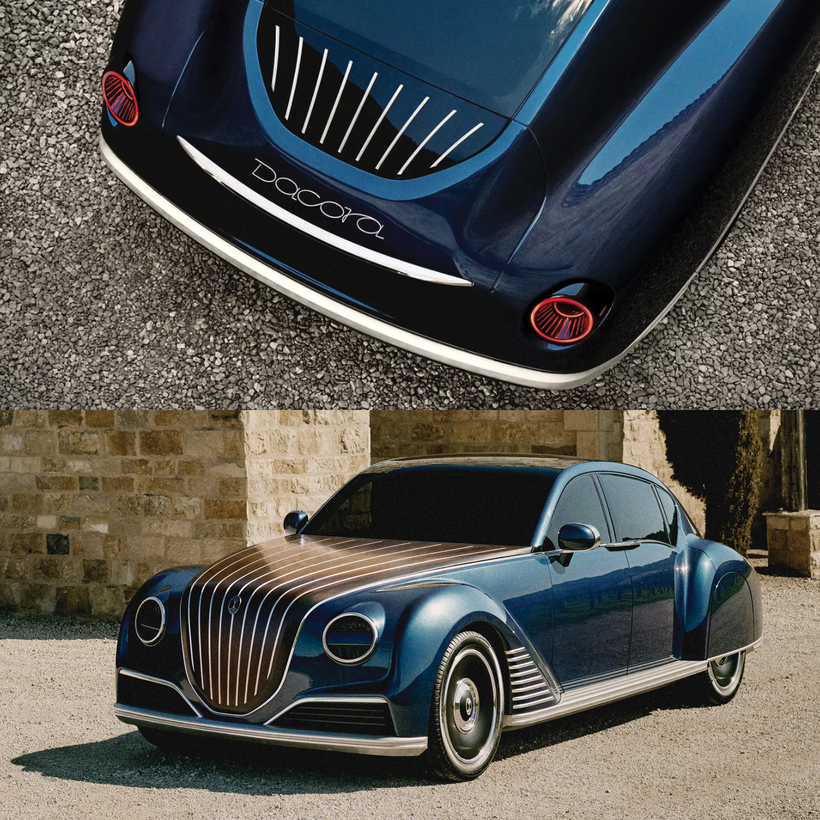It’s not every day one gets invited to inspect a prototype of a $650,000 Pininfarina-designed battery-powered limousine, much less a retro-pastiche land yacht with a wooden hood that’s still being fleshed out on Long Island but is slated to go into serial production from a factory with an adjacent hotel and hospitality center in Hudson, New York, in 2028.
That’s years off and, frankly, it’s an improbable tale—mom and pop build an ultra-luxury car its makers call “a Rolls-Royce for America,” in the Hudson River Valley. But, ever curious and dreamer-positive, I accepted the offer and headed to Long Island’s Port Washington for a look-see.
Dacora Motors is the brainchild of Kristie and Eric D’Ambrosio-Correll and takes its name from the married couple’s double-barreled surname. “It’s a long tradition of auto companies being named after their founders,” Kristie explains. “But no one would ever want a car named D’Ambrosio-Correll, so we shortened it.”

The duo’s considerable ambition and previous careers in engineering—computer and electrical for Kristie, the firm’s C.E.O., and mechanical for Eric—may not take you all the way to launching a successful car company. But they’re undaunted and ready to show me their prototype, which awaits, still under construction, in an adjoining garage. It goes without saying, they are nuts. But good nuts, and their future prospects will in great measure depend on the car I am about to see.
I can honestly say the Dacora looks like nothing else. Certainly nothing the great Italian design house Pininfarina, with which the D’Ambrosio-Corrells are collaborating, has previously been associated with, either.
At the same time, the Dacora looks like a lot of things, a mash-up of several decades in automotive design, starting with big sweeping fenders front and rear, redolent of the 1930s. A side window with an unusual angled cut above the rear fender recalls a signature cue of Packard stylist Howard “Dutch” Darrin, while the car’s rear aspect awakens memories of the Bentley Continental of the 1950s (itself a tribute to General Motors’ late 1940s Cadillac fastbacks), the gargantuan boat-tail Buick Rivieras of the 70s, and the Bugattis and “boat-tail” Auburn speedsters of the 1930s. The car is huge at 20 feet in length and looks even bigger in the metal. Did I say metal? The prototype’s body is made of fiberglass, but production models will be made from aluminum and steel.
The sense of vast acreage is multiplied by the cabin and its four brutalist slab side doors. Jarringly modern, they might rest easier on the eye were they to ride above an old-fashioned running board, but then you’d lose the modern/vintage juxtaposition. Capping it all off is a most unusual hood (or bonnet, as they say in Rolls-Royce’s homeland) completely covered in a wood veneer. No grille opening is needed, as the Dacora’s electric motors and batteries are in the skateboard (more on that shortly) and cooled separately.
The world economy and the fate of the planet being notably out of whack, it’s not entirely surprising when new car-makers spring up these days, typically to serve the fickle demands of the increasingly well-heeled, environmentally aware rich. The expense of engineering, producing, and marketing a new vehicle—along with the practical impossibility of competing with all the technological advantages of competitors one thousand times bigger and one million times more experienced—have for the longest time spelled all but certain failure for aspiring practitioners of the high-dollar automotive arts. But a couple of things have changed, and they seem to undergird the ray of hope Dacora’s managers and investors see.
Firstly, with the current period’s profound wealth concentration, the market for hyper-expensive automobiles is growing, if not in absolute numbers of potential buyers, then in the sheer number of cars any one of the mighty few might buy.

Secondly, there’s one of the lesser-known benefits of the electric-car movement: the “skateboard” chassis. Developed at the turn of the century by General Motors under the direction of its then head of research and vehicle development, Christopher Borroni-Bird, the chassis debuted in a hydrogen-powered E.V. concept-and-show car called the Hy-Wire in 2002. In a skateboard chassis, all the vehicle’s batteries are tucked inside the perimeter of its rigid frame, along with the propulsion system, suspension, braking, and steering. Everything is enclosed by a flat floor. On top of this skateboard can be placed any car or small-truck body that fits. Since it is relatively easy to adjust the platform’s width and length, Tesla was able to copy GM’s design years later, minus the hydrogen fuel cells GM also squeezed into theirs. Advantages include greater interior space, better ride and handling owing to a lower center of gravity, and a more robust chassis. Turns out the strength and rigidity needed to protect battery cells improves occupant safety, too.
With the arrival and mounting acceptance of the skateboard, the state of automotive-manufacturing possibility has changed, as the process of designing car bodies to fit on top of a skateboard is considerably less time-consuming and less costly than having to build a car from the ground up, which is what automobile manufacturers have been doing for close to 75 years.
While greater mass production of skateboard chassis seems inevitable, it creates another key business opportunity. Thanks to the fact that rolling skateboards contain 90 percent of a working automobile, today’s state of play is suddenly more like that of the 1920s and 1930s, when wealthy purchasers might have chosen the finished running chassis with the engine and transmission of a Cadillac or Rolls-Royce and pay a coachbuilder—say, Brewster in the United States or Thrupp & Maberly in England—to complete it with a one-off or low-volume body style of their choosing. One paid a considerable premium over a standard model offered by the car-maker, but in the old Gilded Age, it was considered an important marker of one’s elevated status.
In our new Gilded Age, a new breed of unspeakably rich social astronaut has been similarly drawn to the exclusivity ensured by bespoke bodywork. Witness Rolls-Royce’s La Rose Droptail model of 2024. Though not built on a skateboard chassis, it was one of a series of five one-offs Rolls built, one that probably couldn’t have been yours (best customers first) for a mere $30 million. (Jay-Z and Beyoncé are reported to have bought one.) As if anticipating the Dacora, the enormous convertible featured exotic wood veneers inlaid on its rear deck.
So, the market exists. And there is much encouragement in the knowledge that Dacora intends to use a skateboard from “a well-known American O.E.M.” They declined to specify which Original Equipment Manufacturer they’ve chosen, but those keeping score at home will know this means they’ll rely on one of three choices: Tesla, Lucid, or Rivian. My best guess is Lucid, the best choice, too, since the Lucid Air is one of the quickest, best-handling electric cars in the world, its skateboard the handiwork of founder Peter Rawlinson, who was earlier credited with the design of Tesla’s original Model S. The Lucid chassis is packed with many of the improvements he imagined for Tesla, from which he departed after falling out with his then boss, the self-proclaimed “Imperator of Mars.”

The Dacora’s cabin, not yet ready for final viewing, promises to be handsome, with buttons and knobs refreshingly replacing endless touch menus and touch screens. The goal, its makers say, is a machine that can be experienced with equal satisfaction by owners who drive and those who pay others to drive for them. But today the talk is more about optional extras and the experience Dacora hopes to sell.
“A big part of what we’re selling is personalization, both before purchase and after purchase. So, a lot of customization, flexibility. The vehicle upholstery can be changed by season if you want. We have an upholstery system where, within a couple of hours, you can swap out all of your seats and interiors. If you want something different, for summer, the winter, we’ll release new collections. Additionally, all seating is modular. So if you want to go from bucket seats in the back to a bench seat, that will just be a swap out.”
And then, perhaps most substantially, there is the great unifying theme among makers of exotic automobiles, the experiential element that brings customer and car-maker closer together.
“We’re the only direct-to-consumer ultra-luxury brand,” Kristie says. “We don’t inherit a dealer network, so you’ll get a very different customer experience with us. It’s much more concierge, much more personal, since we’ll be able to directly interact with everyone. We’re in the process of closing on a 100-acre property [in Hudson, New York], and we’ll be developing it to be a combination manufacturing site and the property we’ll be renovating. Owners will get a chance to come stay with us, have a membership-club type of experience, and get to interact with the craftspeople at the factory to be run much more like an atelier than a large assembly-line factory.” Employing 10 people currently, Dacora hopes to staff up to 300 by 2028.
For the D’Ambrosio-Corrells and Dacora, the journey—“Certainly not for the faint of heart,” Kristie sums up—has begun. They’re accepting $50,000 deposits to hold a place in line. Though the Dacora’s looks could well prove polarizing, with reasonable cases to be made for and against, its unique style, coupled with its size and guaranteed turn of speed, confer a distinct baller-tude that will, if the founders realize their dream, surely find an appreciative audience.
Jamie Kitman is a car columnist at AIR MAIL


